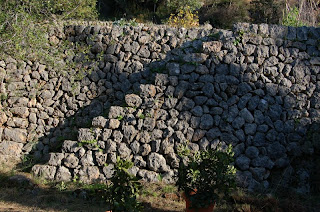


Such work as has been done since the last posting has involved some very old olive trees, medium-sized pines and very small fruit trees. Also taking stock of more shifting terraces and fire hazards. The first pic shows an olive from which decades-old suckers have just been removed. It needs pruning too, but that will have to wait until next year. In this case the terrace collapse seems to be due to the tree, which is also stopping it from going further. Some other walls are showing the bulge which means real collapse is in the offing. They can go on for a very long time looking bulgy, but at least one moved disconcertingly after a
recent heavy rain. There is a slight bulge just to the right of the beautiful steps which lead to the lowest terrace. These are all angled inward, giving you a much greater feeling of security than the narrow steps would otherwise.






Several olives were very overgrown with suckers. Unfortunately a pine just above one of these fell the way it wanted to rather than the way I tried to get it to fall, and broke one of the two remaining good branches. The older suckers are up to 15cm in diameter, and are the preferred material for fence-posts.



Having finally cleared the space, doing a spot of pruning of carobs as well, it was time to dig a few holes. These were not too hard after some rain, and could pretty much all be done with the two-handled fork. I worked an area of about 2m in diameter. working the soil first from the outside in, making a mound, then from the inside out to make a crater. I tried to dig the middle a bit deeper, but the ground becomes extremely stony below about 40cm. As there is have no really composted compost to hand I used some bagged stuff to condition the soil. From the verges of the Alconasser road can be scraped some nice encina semi-compost which was applied as mulch, but it is full of not yet decomposed acorns and leaves, so I thought best not to dig it into the soil. First to go in were 3 nectarines, all new-ish varieties: fantasia, snow queen and red glover. Also a kaki fuyu, a loquat (argelino) and one fig, coll de dama blanca. I'm hoping to put in quite a few more figs next year, sourcing them from among the 40-odd old Mallorquin varieties distrubuted by Slow Food Baleares in collaboration with Vivers Llabres in Manacor. You have to order them now for next year, which I've done along with 3 apricots, 3 apples and a plum, all old varieties from Mallorca or Menorca. The standard apricots on offer are commercial varieties grown in inland areas of the peninsula, which makes me suspect the chill-hours here may be insufficient.


Veg garden somewhat neglected, but some greens to be had. At mid-winter all but the inside ends of the beds got 4 hours of sun, now it's up to 5. With mostly mild as well as some chilly weather, bok choi and komatsuna seeded mid-November now ready to eat. Broccoli is still going, the hybrid green spear producing best. September sown peas still producing a few, while November sown ones have a first flowers. Havas have lots of leaf and flower, but pod-set has not been great - hopefully it will improve now that more sunshine has brought out some bees.

The creation of any sort of aesthetic garden has been small and slow, but clearing has revealed some nice plants that were hidden by the tangle of wire-grass. The sea-quill, Urginea maritima, was growing right along the edges of a couple of terraces. The leaves dry up in summer and it forms an enormous bulb, up to 1kg in weight, from which a spike of white flowers bursts at the end of summer when all around is dry. There is also an abundance of the beautiful heather Erica multiflora. Having enjoyed the mauve flowers until the year's end they are now a rust-red. Much of it is leaning outwards from growing under pines, but I have noticed it grows back vigorously after being cut. Also discovered some bee orchids at the edge of another terrace, mow in flower. There's lots of lentisc, Rhamnus and Cistus, and a few Arbutus, all nice plants to have around. The only things I am trying to get rid of completely are bramble (one small plant found) and spiny broom. Smilax aspera is too prevalent to hope to eliminate, so will probably just have to keep pulling up (or down) this hook-spined climber from time to time.
No comments:
Post a Comment